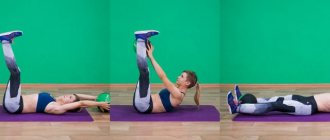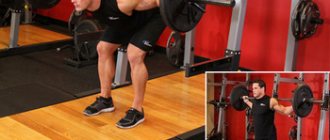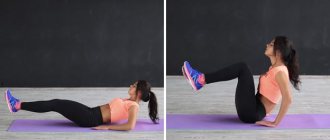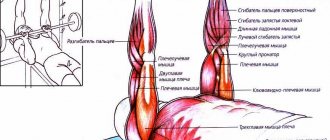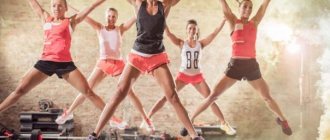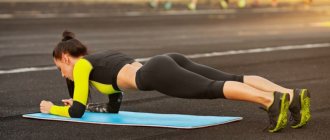Exercises to strengthen the muscles of the lower body should be performed in accordance with standard techniques, following the recommendations of a fitness trainer based on the health status of the individual. One of the most effective options for leg loads is the “Scissors” exercise.
You can do it either in the gym with additional weights or at home with your own weight.
What muscles work in the leg scissors exercise?
When performing the “scissors” exercise for the legs, it uses not only the muscles of the lower body, but also the abs, and also, if dumbbells are used, the arms, shoulders and pectoral muscles.
Leg and abdominal muscles working in the “Scissors” exercise
The main load in this case is distributed between:
- iliopsoas muscle (located in the lower abdomen and is considered one of the most difficult muscles to reach during traditional sports activities);
- rectus abdominis muscle (part of the abs that is used when performing the vast majority of exercises, regardless of the starting position, as well as the targeted muscle area);
- long abdominal muscle. It is a type of internal muscle that requires special exercises to work out. “Scissors” is one of them;
- adductor brevis (a part of the muscle with which a person can bend the leg and externally rotate the hip);
- pectineus muscle . This is the part of the thigh musculature that is located between the crest of the pubis and the pectineal line of the femur. Responsible for the ability to bend the hip and rotate it externally;
- transverse abdominal muscle (the condition of this part of the muscle determines waist circumference, the ability to maintain balance, and also maintain beautiful posture for a long time without overstraining the back);
- quadriceps . The quadriceps femoris muscle is the largest of all the major muscle groups in the lower half of the human body. This is one of the stabilizers in the “Scissors” execution.
What muscles does it use?
The exercise has a particular effect on the abdominal and thigh muscles. Most work during its execution:
- abdominal muscles responsible for the abs: rectus, oblique and transverse;
- vastus lateralis;
- rectus femoris muscle;
- adductor magnus and longus muscles;
- hamstring biceps.
Muscles that are most involved when performing the scissors exercise
Benefits and advantages for women
Among the main positive effects of the “Scissors” exercise on the female body and body, fitness trainers name:
- tightening the lower abdomen. In most cases, it is the lower abdomen that is the most problematic in girls of average or full build. Female physiology is such that the deposited fat mass is concentrated precisely in this area, since nature provides for the preservation of the ability for a woman to bear a child, regardless of the external conditions in which she has to be;
- the entire abdominal area becomes flatter (despite the fact that when performing the exercise the main load is on the lower part of the abs, other muscle groups in this area are also involved, although not to such a significant extent);
- strengthening and tightening thigh muscles (due to the fact that the lower limbs become more slender, the clearance between the upper parts of the legs increases, which has a positive effect on the overall appearance of the girl);
- a visible decrease in waist volume (this becomes possible by reducing the number and size of folds on the sides of the athlete);
- increasing overall body flexibility;
- strengthening the muscles in the lower back;
- active fat burning. In 7-10 minutes of performing “Scissors” in various variations, it is possible to burn up to 70 Kcal. To maintain the speed of metabolic processes, which directly affect the reduction in the amount of subcutaneous fat, fitness trainers recommend that their clients alternate exercise options within one workout. For example, as the final stage of the lesson, you can perform the classic “Scissors”, and then do this exercise with weights previously attached to the legs.
Flaws
The leg scissors exercise, along with its advantages, also has a number of disadvantages.
They must be taken into account when deciding whether to include these loads as a permanent component of the training complex:
- inability to make the abdominal muscles pronounced (despite the frequency and correctness of performing “Scissors”, it is impossible to achieve “cubes” in the lower abdomen with their help);
- the risk of harming one’s own health if the exercise is performed incorrectly (for example, failure to follow the recommended technique can lead to strained leg muscles, pain in the lower abdomen, as well as deterioration of the muscles of the back and neck);
- the presence of absolute contraindications to performing “Scissors” (ignoring these recommendations can lead not only to a decrease in the effectiveness of physical activity, but also to a deterioration in the health of a particular person);
- the presence of details in the “Scissors” technique, which must be taken into account for safe sports activities (most often such nuances, for example, the position of the chin, are not perceived by the athlete as an important detail, which increases the risk of injury during sports activities);
- low effectiveness of the exercise for people with a large amount of subcutaneous fat (due to excess weight, it becomes difficult to perform “Scissors” correctly, which means there will be no result from such exercises, regardless of their regularity).
Benefits of Exercise
The exercise can be practiced at home - no special equipment is required; depending on the type, you may only need a mat for practicing.
When performing the exercise with your legs, the muscles of the lower abdominal press are worked out. The transverse muscle is also involved - this is important, since as a result of training, posture improves and the back muscles are strengthened.
The exercise is used to pump up the abdominal “cubes”: it will benefit men who value body contour. The hips and buttocks are strengthened - you can’t do without “scissors” if you want to have a beautiful and firm butt.
Within 10 minutes of training you can burn up to 70 calories, so the exercise will be effective for those who are overweight.
Exercise in a pool or open water - spend up to 150 calories. “Scissors” are suitable as one of the warm-up exercises before the main training. If you increase the number of repetitions and approaches, they will become a full-fledged exercise as part of the training complex.
Contraindications
The “Scissors” exercise, like other variants of physical activity, has a number of contraindications, which must be taken into account when making a final decision on the advisability of including loads of this type in a training complex.
Contraindications:
- benign or malignant neoplasms in the lower part of the body. Muscle pumping stimulates local blood circulation, which increases the rate of metabolic processes in the body. With the acceleration of metabolism, the neoplasm will be fed with blood, which can lead to both tumor growth and its transition from the “benign” to “malignant” type;
- increased body temperature (regardless of the reasons that provoked a change in its level);
- exacerbation of chronic diseases (of any type);
- inflammatory processes in the body, regardless of the area of their occurrence;
- back or lower extremity injuries;
- recent surgery (if less than 6 months have passed since the operation);
- menstruation (at the beginning of the cycle, it is not recommended to load the muscles of the lower abdomen, as this can lead to an increase in the volume of discharge and the onset of bleeding, which can only be stopped with medication);
- serious diseases of the cardiovascular system (for example, tachycardia, arrhythmia, and so on).
Pros of exercise
If you regularly perform the scissor exercise, the benefits will manifest itself in the following advantages:
- Development of all abdominal muscles.
- Effective pumping of the cubes located in the lower abdomen.
- Reducing body fat, creating a flat stomach and thin waist.
- High-quality workout for legs, thighs and buttocks.
Few people will say: I can’t do the scissors exercise, since you can’t get injured while doing it. In addition, it is recommended for athletes with injuries and for pumping up the abs.
This complex is considered one of the most effective for abdominal training, but not the best. The first place here belongs to such a movement as a bicycle.
Many beginners will be interested to know how many calories are spent on scissors. 10 minutes of continuous movements will help burn 70 kcal, and the reverse option will eliminate about 90 kcal. If you exercise in the pool, you can increase the load in this way. The value can be increased to 120 kcal during the same time.
Leg exercise options
The leg scissors exercise can be performed in several ways, the most effective of which are:
| Exercise | Execution algorithm |
| "Bent Scissors" |
|
| "Diagonal scissors" |
|
Secrets and subtleties of the exercise
- Keep your core still and do not move your arms during the exercise.
- Raise your legs straight without bending your knees.
- Don't forget about proper breathing.
- Do not chase speed, perform ascents and descents at an average pace.
- In 10 minutes of training, 60–80 kcal are burned. By the way, reverse “scissors” are more effective in this sense.
- To burn 100-110 kcal in 10 minutes, do the exercise in the pool . The effect of 40 minutes of such training can be equal to the effect of strength training.
- For best results, 3-4 workouts per week in conjunction with other exercises to strengthen the abdominal muscles.
- During one workout, do 3 sets of 45-60 seconds each. The number of swings depends on your physical fitness.
- A noticeable effect from the exercise can be seen 2 months after the start of training.
Performing the scissors exercise with dumbbells
The scissors exercise can be made more difficult by doing it with dumbbells.
The “scissors” exercise is distinguished not only by its accessibility, but by its benefits and effectiveness. Vertical and horizontal swings can pump up your hips and abs in a relatively short time. But for impressive results you need constant physical practice. And most importantly, remember - everything has its time. Don’t overestimate your capabilities and don’t rush to move to the next level, and then you will be rewarded with a flat tummy, slender legs and elastic buttocks, and you will be able to leave only positive reviews about the exercise.
Technique for performing female scissors at home
The technique for performing female scissors at home may vary depending on the physical fitness of the individual athlete.
Beginners
Girls who have no experience in sports are recommended to do “Scissors” like this:
| Exercise | Execution algorithm |
| Classic scissors |
The total number of approaches should be at least 3 pieces. |
| Alternate leg raises |
|
Pro
Girls who already have previous experience in sports are recommended to do “Scissors” like this:
| Exercise | Execution algorithm |
| Weighted scissors |
|
| Reverse scissors on the floor | The technique for performing this exercise is similar to the above. The only difference is the starting position. In this case, the athlete should lie on her stomach, lowering her limbs 1-2 cm to the floor with each crossing of her legs. The exercise should not provoke pain or discomfort in the back (if there is discomfort, it is recommended to reduce the load, for example, remove weights, or exclude this exercise from the training complex). The optimal number of repetitions is 10, and approaches are 5 pcs. |
Technique of performing while lying on your back
- Lie on the floor, place your arms along your body, palms on the floor (or rest them under your tailbone for additional support), raise your legs at an angle of 25-40 degrees.
- Perform cross swings by placing one leg behind the other (vertically or horizontally).
- Maintain tension in your abdominal muscles throughout the entire approach.
In the classical technique, it is correct to do the scissors exercise so that your back is completely adjacent to the floor.
Scissor exercise in the gym
“Scissors” can be done not only at home, but also include this exercise for the legs and abs in a training complex intended for athletes working out in the gym:
| Exercise | Execution algorithm |
| Reverse scissors on a horizontal bench |
|
| Vertical scissors |
|
Common execution errors
The most common mistakes that athletes make when performing scissors:
- raise your back from the surface, which can lead to spinal injury;
- bend the knee joints and thereby reduce the load on the abdominal muscles;
- They tear their heads off the floor, which is why they quickly lose strength.
The scissor exercise is a simple way to train your leg and abdominal muscles. It has a number of advantages and has no contraindications. If you do it correctly, you will quickly achieve your goal.
Possible mistakes
When performing “Scissors,” fitness trainers recommend that athletes pay special attention to maintaining the technique.
The most common mistakes made not only by beginners, but also by people who regularly play sports are:
- raising the lower back from the floor while changing the position of the lower limbs (this mistake can lead to overstrain of the lower back muscles and also increase the risk of spinal injury);
- bending the legs at the knees when changing the position of the lower extremities (if the legs are no longer straight, the load on the abs is automatically reduced, which leads to a decrease in the effectiveness of the exercise);
- raising your legs too high . This mistake is often made by people with strong abs, who believe that a large distance between the floor and legs is the key to the high effectiveness of the exercise. In the initial position, the legs should be raised no higher than 90 degrees from the floor, and in the lower position, if a complicated version of “Scissors” is performed, there should be 5-10 cm between the floor and the limbs;
- neck tension in the process of moving the legs during the exercise (due to incorrect distribution of the load, athletes will not be able to achieve the most effective workout of the abdominal muscles and legs due to the rapid onset of fatigue and associated discomfort).
“Scissors” is one of the most effective exercises with which you can strengthen not only the leg muscles, but also the muscles of the abdominal region.
To achieve the desired result (for example, increasing endurance, drawing relief, losing weight, and so on), it is important for the athlete to follow the exercise technique recommended by the fitness trainer, as well as to exercise regularly, at least 3 times a week.
What's the benefit?
Any feasible workout is beneficial for the human body. And including leg swings in your exercise can lead to the following results.
- Ab scissor exercise helps increase oxygen supply to the entire body and especially to the abdominal muscles.
- Incorporating scissors into your workout will benefit the most problematic part of your abs—the area just below your belly button. But at the same time, during execution, absolutely all the abdominal muscles are worked out, so this area of the body will become more toned.
- If you regularly do scissors, it will benefit not only your abs. The thigh muscles will also tighten and visually lengthen. And the interfemoral gap will become more noticeable.
- Such activities are good for burning extra calories, which means they help with weight loss. It is estimated that 10 minutes of intense scissoring will burn about 70 kcal. Therefore, such exercises are often included in a set of exercises for obese people. Normal motor activity in such people is reduced due to the high load on the knee joints, and scissors help compensate for this deficiency if done quite regularly, albeit little by little.
- In addition to abs and thighs, such workouts help make your waist more defined.
- The back muscles are strengthened. Moreover, the benefit will be not only from muscle movement, but also from the work of the lower vertebrae.
Expert opinion. All of the above is very important in the rehabilitation of some patients. This primarily applies to those people who have had a hip fracture. The inclusion of leg swings in the exercise therapy complex helps speed up the rehabilitation process. The fact is that during training, quite a lot of muscles are involved that are responsible for walking and running.
In addition to all this, the advantages of leg swings include the fact that no special equipment is required to perform them, and that you can independently regulate the difficulty and intensity.
The main muscles that work when performing this exercise are the rectus abdominis, oblique, and rectus femoris. But in addition to this, many small muscles are also involved in the work, most of which are very difficult to work.
According to the American Council on Exercise for 2020, this exercise is the top ten most effective for the abs.
Exercise “Scissors” for perfect legs: 4 levels of difficulty
We will talk about the all-familiar “Scissors” exercise. About its value, advantages, implementation procedure, as well as “fine points”. Follow our instructions, achieve your goal, stick to a proper diet - and you are guaranteed a flat stomach, toned thighs and buttocks, general vigor and a great mood
Pros and fitness enthusiasts have a lot of tricks in their arsenal to quickly and effectively tighten their abdominal muscles. However, swinging on exercise machines, sometimes from the same angles and under repeated loads, often becomes boring not only for us, but also for our “abs”. In addition, they are contraindicated for some back injuries.
Exercise “Scissors” for perfect legs: 4 levels of difficulty
We will talk about the all-familiar “Scissors” exercise. About its value, advantages, implementation procedure, as well as “fine points”. Follow our instructions, achieve your goal, stick to a proper diet - and you are guaranteed a flat stomach, toned thighs and buttocks, general vigor and a great mood
Pros and fitness enthusiasts have a lot of tricks in their arsenal to quickly and effectively tighten their abdominal muscles. However, swinging on exercise machines, sometimes from the same angles and under repeated loads, often becomes boring not only for us, but also for our “abs”. In addition, they are contraindicated for some back injuries.
Pose variations4
Like all other Kama Sutra positions, the scissor position in sex has its own specific variations. So, a woman can lie on her back during intercourse, and a man can face her, lying on his side. In this case, one of the girl’s legs is thrown over her partner’s arm, bent at the elbow. Her other leg “slips” between her partner’s legs.
In another variation of the pose, the man lifts part of his body and holds himself in this pose with the help of his left hand. At the same time, his right hand is located on the woman’s chest. The partner's slightly bent right leg is between the girl's legs. The pose is very interesting and completely uncomplicated. It ensures maximum penetration of the penis into a woman.
Another version of the pose is for the woman to lie on her back with her legs bent to the sides. The man sits down facing the girl. The buttocks of the partners touch, and the man’s legs are located on the sides of the partner.
Program for pumping the press
Developing your abdominal muscles is not such a difficult task. The main thing is to enjoy your training. The proposed abdominal program must be performed 2-4 times a week, repeating the exercises as slowly and technically as possible. If you do this correctly, you will feel a slight burning sensation in your abdominal muscles.
Otherwise, if you do the exercises in the program incorrectly, the result will be pain in the lower back and lower back. Also, beginners often overextend their neck muscles, which causes characteristic pain. When performing a set of abdominal exercises, try not to strain your neck.
The result of the program will be a gradual strengthening of the abs - you will notice the first result in a week, but a noticeable effect will appear only after a month of active training. This is why it is important to develop the habit of performing a set of exercises regularly, and not expect a complete transformation of the abs on the first day.
***
The first rule in training the abdominal muscles is the comprehensive and conscious involvement of the abdominal and core muscles in the work. The second rule is a slow rhythm of doing exercises and control over their technique. The third rule is a consistent path to results, and not an attempt to achieve an effect in one workout.
For beginners
Before starting the lesson, you need to warm up. It will not take much time (5-7 minutes is enough), it will help warm up the ligaments and improve blood circulation.
Joint gymnastics, including rotation of the knees, feet, and hip area, is well suited. After this you can start executing:
Take the starting position. To do this, lie on your back and stretch your legs. Hands are placed along the body. You can grab them onto a fixed support from behind (a wall unit, a protruding edge of heavy furniture). Pull the feet towards the body, creating a 30 degree popliteal bend.
Correct breathing. Count silently from 1 to 10, adjusting each number to the phases of inhalation and exhalation. In the future, they adhere to the specified respiratory rhythm.
Perform swings. Raise your legs perpendicular to the floor (90 degree angle), spread them slightly wider than your shoulders. At the same pace, bring the right limb behind the left and vice versa.
- Starting position - lying on your back, arms extended along the body. To make the exercise a little easier, you can grab the edges of the mat with your hands - this will help press your lower back to the floor.
- Bring one leg up perpendicular to the floor, then switch legs without lowering your feet to the floor.
- We breathe with our stomachs, counting in order from 1 to 10: on the first ten, we inhale slowly and deeply, on the second, we exhale.
We repeat the exercise for 20–30 seconds in 3–5 approaches.
The procedure for performing the exercise is the same as described above.
- Lie down in the starting position: your arms are on the back of your head or extended along your body, your legs are raised at an angle of 90 degrees;
- Lower your legs 30 degrees lower and perform the exercise, alternating vertical and horizontal swings;
- Watch the rhythm of your breathing!
Perform 3-5 approaches. The goal is to immediately raise your legs 60 degrees, and do not bend them when lowering to the floor.
After some time, you can go even lower - 30 degrees.
- We lie down on our backs. We place our hands under the lower back or buttocks. Legs at an angle of 30 degrees;
- We perform the exercise using an already known algorithm. The lower back should be pressed tightly to the floor, the shoulder and neck muscles should be relaxed.
We perform at least 3 approaches 3 times a week.
- Take the starting position - lying on your back, hands under your buttocks, legs extended.
- Raise your legs to a height of 10–15 cm.
- Make horizontal or vertical swings without touching the floor surface. Our goal is to gradually increase the frequency of the swings, doing 4 swings per breath.
You can do vertical and horizontal leg swings while lying on your stomach. In this position, in addition to the abdominal and hip muscles, the gluteal muscles are effectively used.
- We take the starting position: lie on your stomach, hands under your chin. You can hold your head straight or rest it on your hands - monitor your sensations and position yourself in the way that is most comfortable for you.
- We make horizontal swings with our legs without touching the floor. Perform 10–20 swings in one approach.
This type of exercise can be complicated if you extend your arms straight in front of you and swing both arms and legs at the same time.
- Position yourself on a bench so that your body is lying on it and your legs are in the air. With your hands, firmly grasp the edge of the bench.
- Perform 10 vertical and horizontal swings, remembering to monitor your breathing and balance.
- Lying on your back, extend your arms along your body, place them palms down. Straighten your legs and raise them to an angle of 60 degrees or higher.
- Slowly lift your pelvis off the floor (your feet should be above your head), supporting yourself under your lower back.
- Take a breath. Lower one leg, the other should remain motionless.
- Change the position of your legs as you exhale.
- Repeat the exercise 10 times for each leg.
- When finished, bring your legs together above your head and slowly lower your lower body to the floor.
Perform this exercise only if you are in good physical condition.
- muscles of the back and abdomen, which stabilize the position of the spine;
- muscles that extend the leg at the hip and knee joints;
- gastrocnemius and soleus muscles;
- muscles that extend the arm at the shoulder joint;
- muscles that help bring the shoulder blades together.
